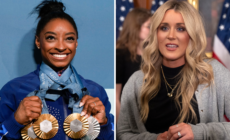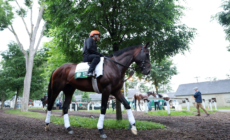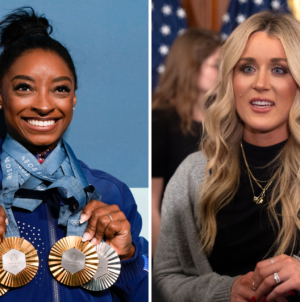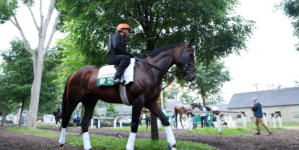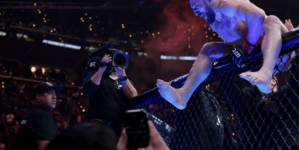-
Chaos erupts at Paramount Home Depot as protesters confront ICE - 17 mins ago
-
Riley Gaines and Simone Biles Beef Online Amid Trans Athlete Debate - 18 mins ago
-
Rod Stewart, 80, cancels 6 concerts as he battles the flu - 27 mins ago
-
Diamondbacks vs. Reds Highlights | MLB on FOX - 44 mins ago
-
Israeli forces in Gaza kill 6 Palestinians seeking aid, health officials say - 47 mins ago
-
FanDuel Promo Code: Claim $500 Belmont Stakes No-Sweat Bet This Weekend - 57 mins ago
-
Sydney Sweeney and Jessica Simpson make fashion statements at events - about 1 hour ago
-
Bet365 Bonus Code WEEK365: Claim $150 Promo For MLB, UFC 316, Any Game - 2 hours ago
-
Stewart Friesen & more post-race interviews from Michigan International Speedway | NASCAR on FOX - 2 hours ago
-
Ted Cruz Urges Trump and Musk to ‘Kiss and Make Up’ - 2 hours ago
Some NCAA Athletes Can Now Be Paid by Schools: What to Know
A multibillion-dollar settlement was approved on Friday by a federal judge, allowing National Collegiate Athletic Association (NCAA) Division I schools to directly pay college athletes for the first time.
House v. NCAA was filed by former Arizona collegiate swimmer Grant House in 2020, challenging a decades-old prohibition on schools cutting checks directly to athletes, according to the Associated Press.
This decision made by U.S. District Judge Claudia Wilken marked a major legal and cultural shift for college sports, ending nearly a century of strict amateurism and paving the way for schools such as the University of Houston, Texas, and Texas A&M to participate in a new revenue-sharing mode.
Under the settlement terms, schools are expected to begin issuing payments to athletes as early as July 1.
The NCAA is set to pay out nearly $2.8 billion in back damages while capping each school’s annual direct payments to athletes at $20.5 million for the 2025-26 academic year.
Why It Matters
This development fundamentally alters the landscape of college sports in the United States, affecting athlete compensation, recruitment, and competitive balance.
For decades, NCAA rules disqualified student-athletes from receiving compensation beyond scholarships, despite the enormous revenues generated by college football and basketball.
The settlement responds to growing advocacy and legal action over athletes’ rights, reinforcing that players are entitled to a share of the wealth they help create.
Experts said the model could serve as a precedent for other states and potentially drive further reforms on a national scale, especially in light of similar legislative pushes like those recently seen in Texas.
getty
What To Know
The settlement in House v. NCAA concluded three federal antitrust lawsuits that alleged the NCAA unlawfully restricted college athletes’ earnings for years.
Wilken’s approval authorized schools to pay up to $20.5 million per year to athletes, with this cap set to increase annually during the 10-year agreement. In addition to new revenue-sharing, the NCAA will disburse nearly $2.8 billion in back payments to athletes who competed from 2016 onward, according to ESPN.
Shortly after the settlement, Texas advanced its own bill permitting universities to enter into direct name, image, and likeness (NIL) deals with student-athletes. The bill cleared the state Senate unanimously and awaits Governor Greg Abbott’s signature. The measure would take effect on September 1, and Texas officials said it was needed to maintain the state’s competitive edge in recruiting and retaining top-tier athletes.
Colleges such as the University of Houston and Texas A&M announced plans to distribute the maximum allowable $20.5 million, with football and men’s basketball expected to receive the majority share of funds. Texas committed to funding all 21 sports up to the full scholarship roster limit, allocating 75 percent of funds to football and 15 percent to men’s basketball, according to the Houston Chronicle.
Schools opting into the settlement, including the Power Four conferences, must designate which student-athletes remain above roster limits by early July, with regulatory oversight shifting to the newly established College Sports Commission.
Questions remain regarding the classification of college athletes as employees, the appropriate cap on compensation, and federal involvement. NCAA and school leaders continue advocating for congressional action to clarify legal uncertainties and preserve a degree of centralized control within college sports.
What People Are Saying
NCAA President Charlie Baker wrote in an online statement on Friday: “Approving the agreement reached by the NCAA, the defendant conferences and student-athletes in the settlement opens a pathway to begin stabilizing college sports,” Charlie Baker, NCAA President wrote in an online statement Friday. “This new framework that enables schools to provide direct financial benefits to student-athletes and establishes clear and specific rules to regulate third-party NIL agreements marks a huge step forward for college sports.”
He added: “…We can now turn toward what most agree is our primary function: providing a world-class academic and athletics experience. With these changes in place, including release from future litigation on these subjects for the next decade, the foundation of college sports is stronger than at any point in years. The NCAA can increase focus on reforming clunky governance structures and, most importantly, prioritizing fair competition, academics and student-athlete well-being.”
Southeastern Conference Commissioner Greg Sankey said in a statement issued to local news station KBTX: “The approval of the House settlement agreement represents a significant milestone for the meaningful support of our student-athletes and a pivotal step toward establishing long-term sustainability for college sports, two of the Southeastern Conference’s top priorities. As the journey to modernize collegiate sports continues, we remain focused on identifying and implementing innovative opportunities for our student-athletes across all sports while maintaining the core values that make collegiate athletics uniquely meaningful.”
What Happens Next?
Schools participating in the settlement will begin direct payments to athletes starting July 1.
Lawmakers and college sports leaders continue to push for further regulatory and legislative clarity at the federal level as implementation proceeds.
Source link

